LOTUS ELISE 2005 Owners Manual
Manufacturer: LOTUS, Model Year: 2005, Model line: ELISE, Model: LOTUS ELISE 2005Pages: 205, PDF Size: 4.51 MB
Page 101 of 205
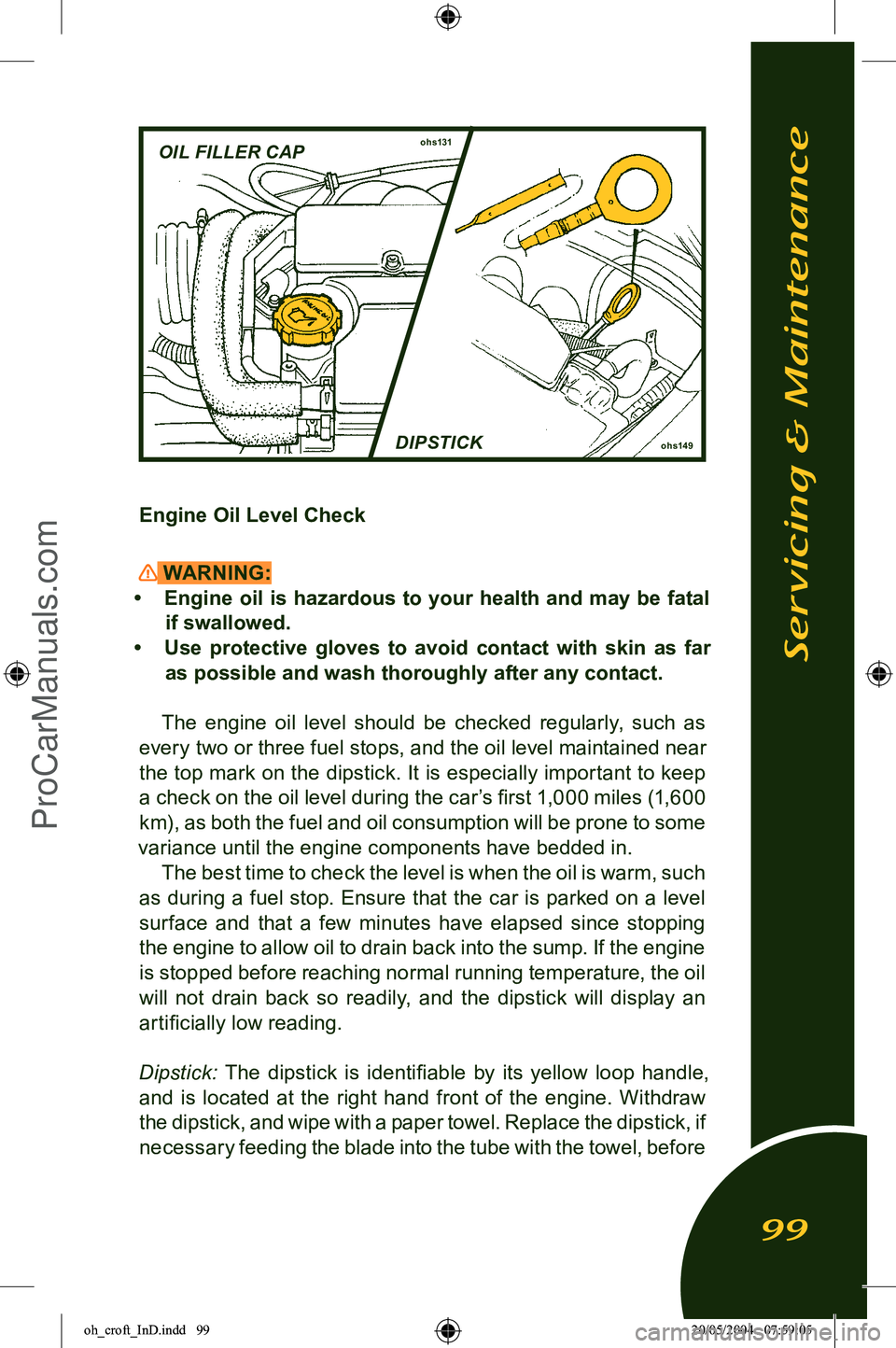
ohs149
OIL FILLER CAPohs131
DIPSTICK
Engine Oil Level Check
WARNING:
• Engine oil is hazardous to your health and may be fatal
if swallowed.
• Use protective gloves to avoid contact with skin as far as possible and wash thoroughly after any contact.
The engine oil level should be checked regularly, such as
every two or three fuel stops, and the oil level maintained near
the top mark on the dipstick. It is especially important to keep a check on the oil level during the car’s first 1,000 miles (1,600
km), as both the fuel and oil consumption will be prone to some
variance until the engine components have bedded in. The best time to check the level is when the oil is warm, such
as during a fuel stop. Ensure that the car is parked on a level
surface and that a few minutes have elapsed since stopping
the engine to allow oil to drain back into the sump. If the engine is stopped before reaching normal running temperature, the oil
will not drain back so readily, and the dipstick will display an artificially low reading.
Dipstick: The dipstick is identifiable by its yellow loop handle,
and is located at the right hand front of the engine. Withdraw
the dipstick, and wipe with a paper towel. Replace the dipstick, if necessary feeding the blade into the tube with the towel, before
Servicing & Maintenance
99
oh_croft_InD.indd 9920/05/2004 07:59:05ProCarManuals.com
Page 102 of 205
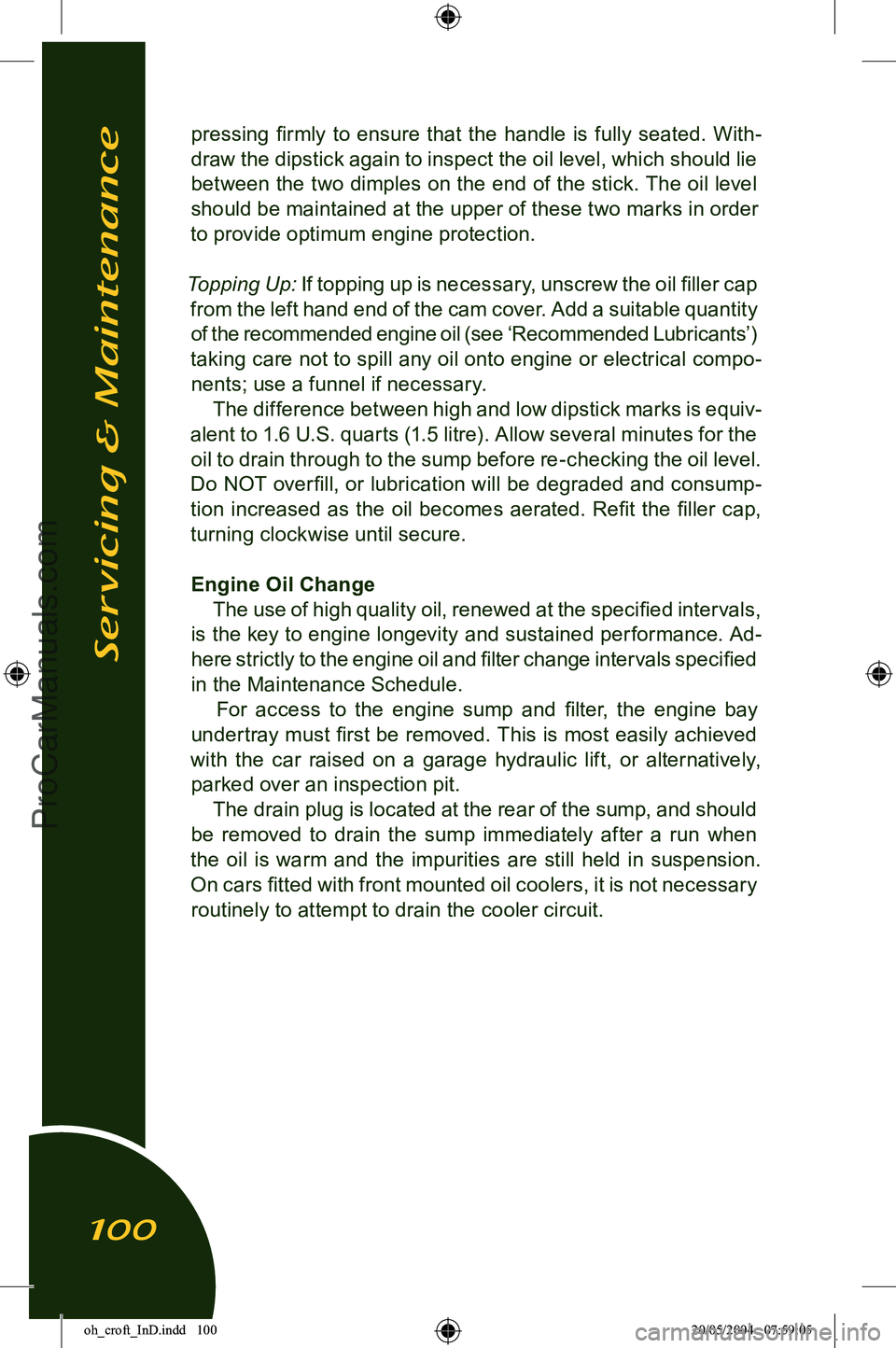
pressing firmly to ensure that the handle is fully seated. With-
draw the dipstick again to inspect the oil level, which should lie between the two dimples on the end of the stick. The oil level
should be maintained at the upper of these two marks in order
to provide optimum engine protection.
Topping Up
: If topping up is necessary, unscrew the oil filler cap
from the left hand end of the cam cover. Add a suitable quantity of the recommended engine oil (see ‘Recommended Lubricants’)
taking care not to spill any oil onto engine or electrical compo
-
nents; use a funnel if necessary. The difference between high and low dipstick marks is equiv
-
alent to 1.6 U.S. quarts (1.5 litre). Allow several minutes for the oil to drain through to the sump before re-checking the oil level.
Do NOT over fill, or lubrication will be degraded and consump
-
tion increased as the oil becomes aerated. Refit the filler cap,
turning clockwise until secure.
Engine Oil Change The use of high quality oil, renewed at the specified intervals,
is the key to engine longevity and sustained performance. Ad
-
here strictly to the engine oil and filter change intervals specified
in the Maintenance Schedule.
For access to the engine sump and filter, the engine bay
undertray must first be removed. This is most easily achieved
with the car raised on a garage hydraulic lift, or alternatively, parked over an inspection pit.
The drain plug is located at the rear of the sump, and should
be removed to drain the sump immediately after a run when
the oil is warm and the impurities are still held in suspension.
On cars fitted with front mounted oil coolers, it is not necessary routinely to attempt to drain the cooler circuit. Servicing & Maintenance
100
oh_croft_InD.indd 10020/05/2004 07:59:05ProCarManuals.com
Page 103 of 205
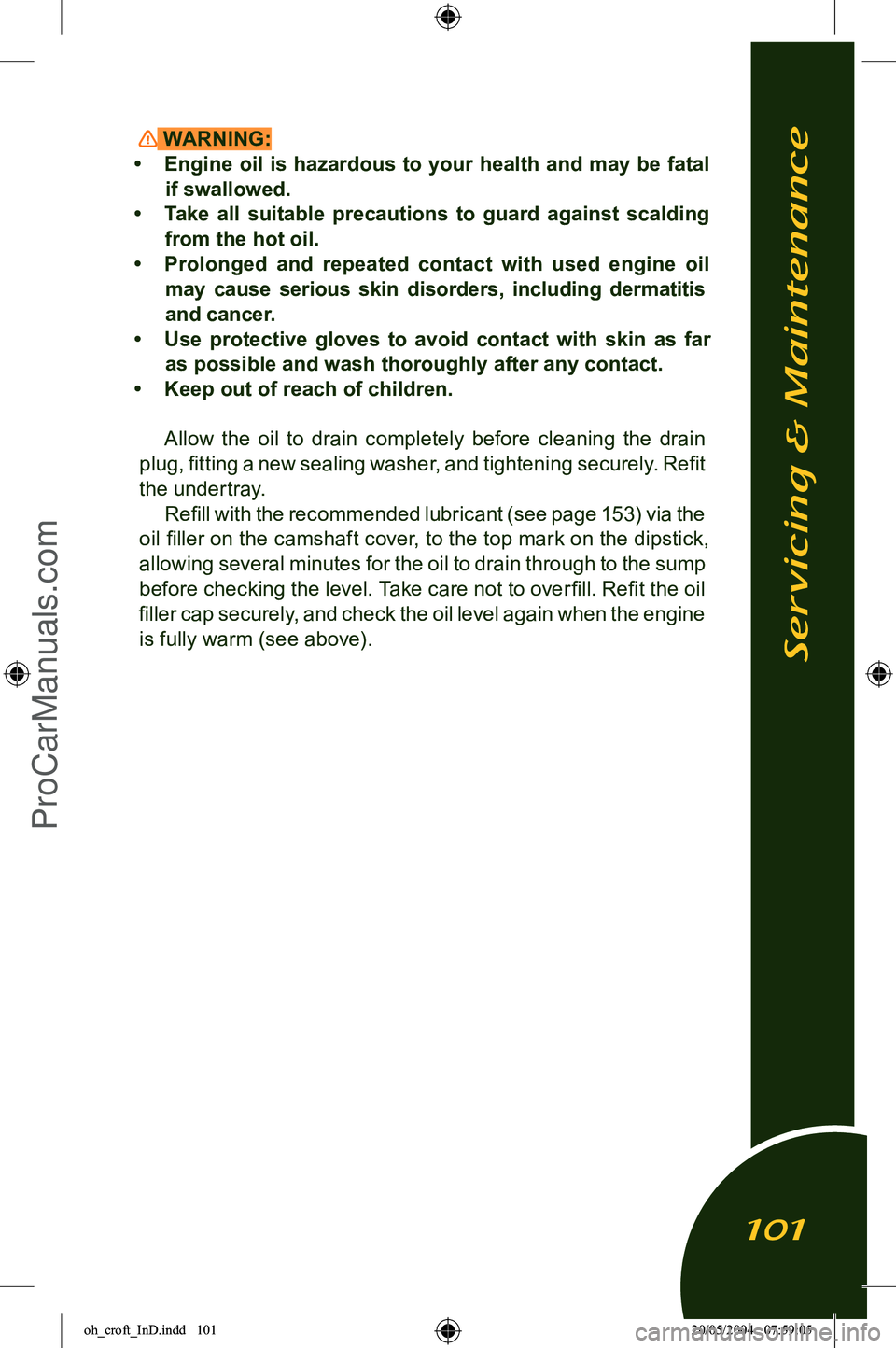
WARNING:
• Engine oil is hazardous to your health and may be fatal
if swallowed.
• Take all suitable precautions to guard against scalding
from the hot oil.
• Prolonged and repeated contact with used engine oil may cause serious skin disorders, including dermatitis
and cancer.
• Use protective gloves to avoid contact with skin as far
as possible and wash thoroughly after any contact.
• Keep out of reach of children.
Allow the oil to drain completely before cleaning the drain
plug, fitting a new sealing washer, and tightening securely. Refit
the undertray. Refill with the recommended lubricant (see page 153) via the
oil filler on the camshaft cover, to the top mark on the dipstick,
allowing several minutes for the oil to drain through to the sump before checking the level. Take care not to over fill. Refit the oil
filler cap securely, and check the oil level again when the engine is fully warm (see above).
Servicing & Maintenance
101
oh_croft_InD.indd 10120/05/2004 07:59:05ProCarManuals.com
Page 104 of 205
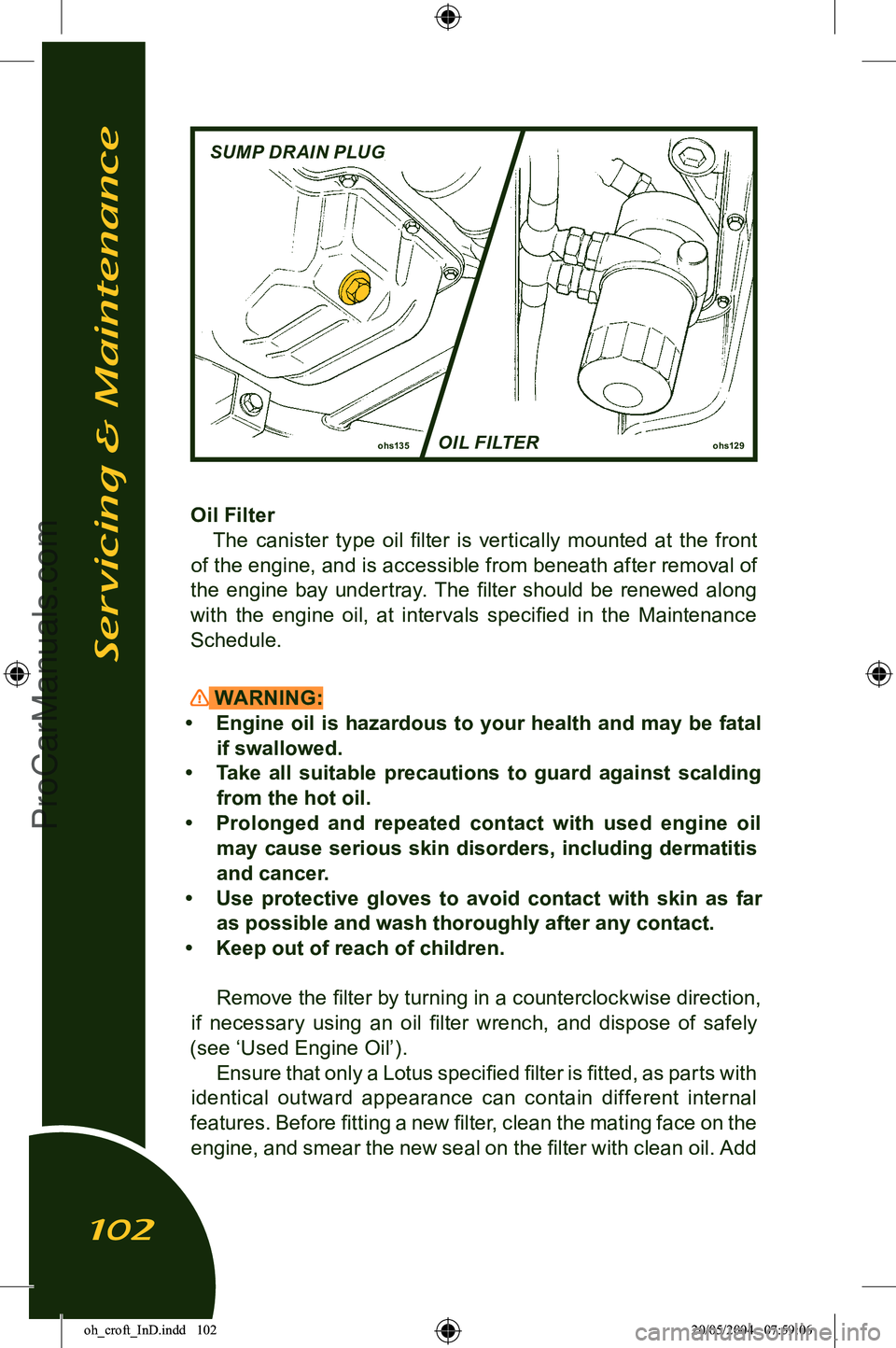
Oil FilterThe canister type oil filter is vertically mounted at the front
of the engine, and is accessible from beneath after removal of
the engine bay undertray. The filter should be renewed along
with the engine oil, at intervals specified in the Maintenance
Schedule.
WARNING:
• Engine oil is hazardous to your health and may be fatal
if swallowed.
• Take all suitable precautions to guard against scalding
from the hot oil.
• Prolonged and repeated contact with used engine oil may cause serious skin disorders, including dermatitis
and cancer.
• Use protective gloves to avoid contact with skin as far
as possible and wash thoroughly after any contact.
• Keep out of reach of children.
Remove the filter by turning in a counterclockwise direction,
if necessary using an oil filter wrench, and dispose of safely
(see ‘Used Engine Oil’). Ensure that only a Lotus specified filter is fitted, as parts with
identical outward appearance can contain different internal
features. Before fitting a new filter, clean the mating face on the engine, and smear the new seal on the filter with clean oil. Add
ohs129
ohs135
SUMP DRAIN PLUG
OIL FILTER
Servicing & Maintenance
102
oh_croft_InD.indd 10220/05/2004 07:59:06ProCarManuals.com
Page 105 of 205
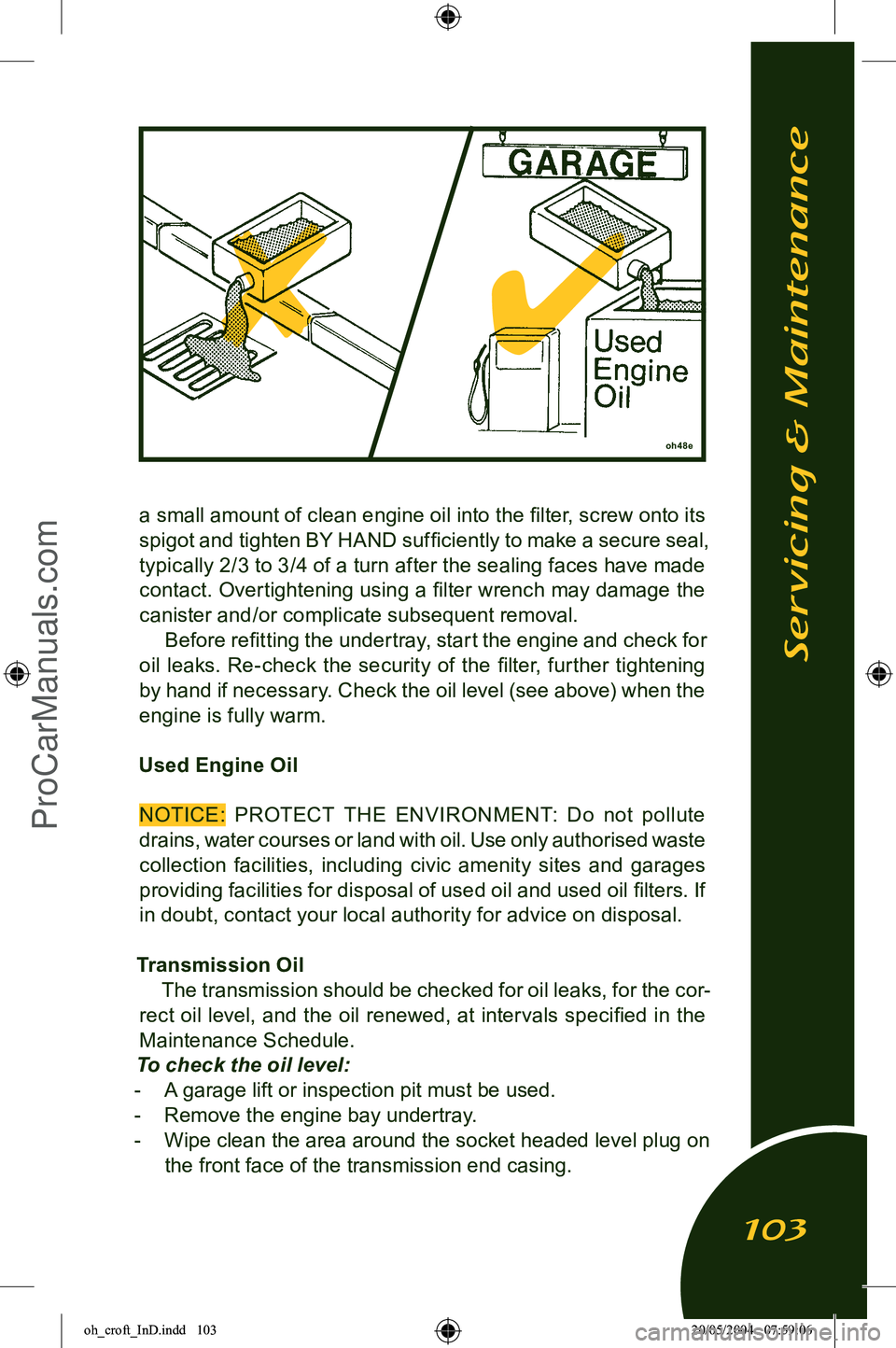
oh48e
a small amount of clean engine oil into the filter, screw onto its
spigot and tighten BY HAND sufficiently to make a secure seal,
typically 2/3 to 3/4 of a turn after the sealing faces have made
contact. Overtightening using a filter wrench may damage the
canister and/or complicate subsequent removal. Before refitting the undertray, start the engine and check for
oil leaks. Re-check the security of the filter, further tightening
by hand if necessary. Check the oil level (see above) when the
engine is fully warm.
Used Engine Oil NOTICE: PROTECT THE ENVIRONMENT: Do not pollute
drains, water courses or land with oil. Use only authorised waste
collection facilities, including civic amenity sites and garages providing facilities for disposal of used oil and used oil filters. If
in doubt, contact your local authority for advice on disposal.
Transmission Oil The transmission should be checked for oil leaks, for the cor
-
rect oil level, and the oil renewed, at intervals specified in the
Maintenance Schedule.
To check the oil level:
- A garage lift or inspection pit must be used.
- Remove the engine bay undertray.
- Wipe clean the area around the socket headed level plug on
the front face of the transmission end casing.
Servicing & Maintenance
103
oh_croft_InD.indd 10320/05/2004 07:59:06ProCarManuals.com
Page 106 of 205
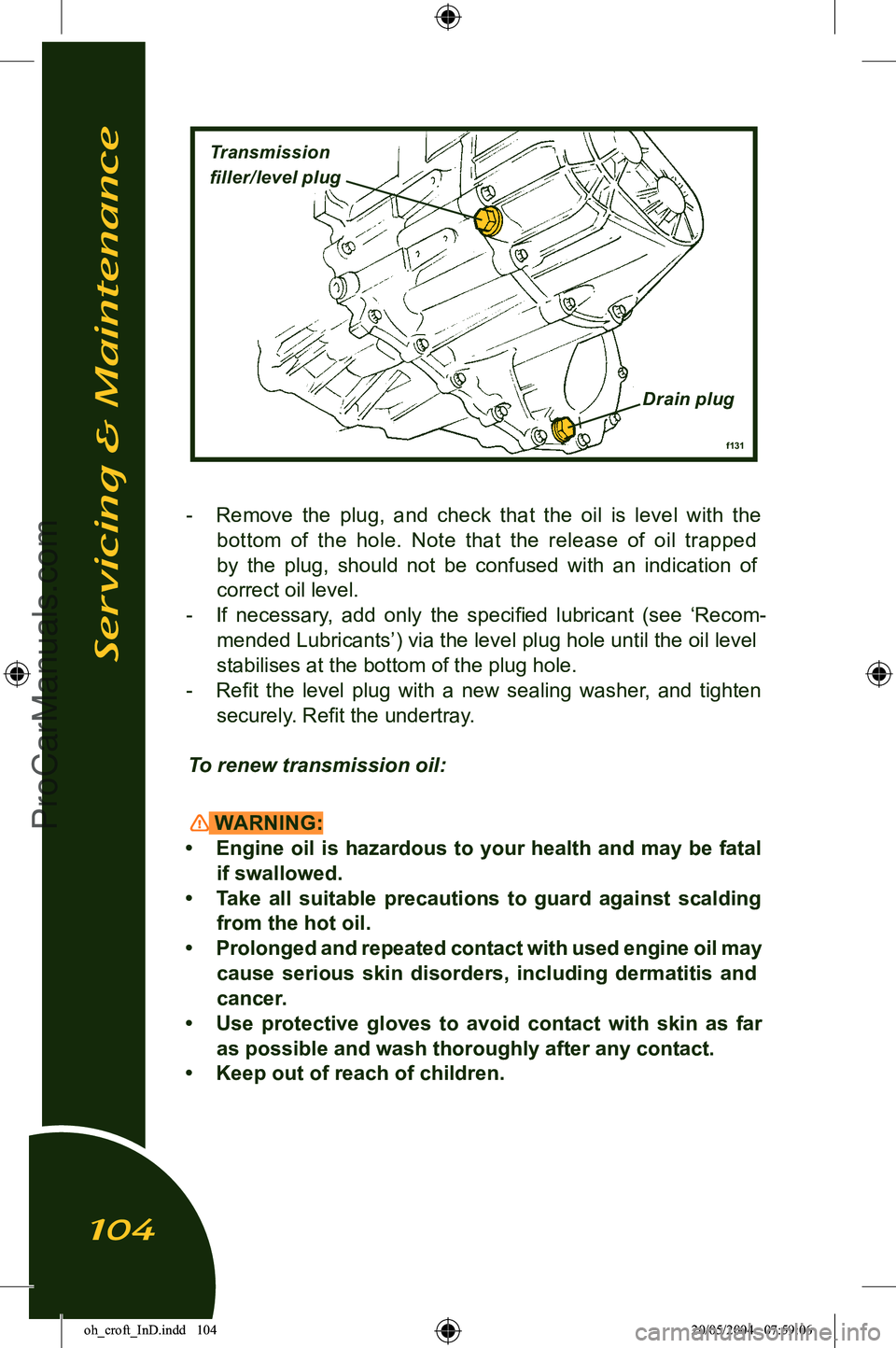
- Remove the plug, and check that the oil is level with the bottom of the hole. Note that the release of oil trapped
by the plug, should not be confused with an indication of
correct oil level.
- If necessary, add only the specified lubricant (see ‘Recom
-
mended Lubricants’) via the level plug hole until the oil level
stabilises at the bottom of the plug hole.
- Refit the level plug with a new sealing washer, and tighten securely. Refit the undertray.
To renew transmission oil:
WARNING:
• Engine oil is hazardous to your health and may be fatal
if swallowed.
• Take all suitable precautions to guard against scalding
from the hot oil.
• Prolonged and repeated contact with used engine oil may cause serious skin disorders, including dermatitis and
cancer.
• Use protective gloves to avoid contact with skin as far as possible and wash thoroughly after any contact.
• Keep out of reach of children.
Servicing & Maintenance
104
f131
Transmission
filler/level plug
Drain plug
oh_croft_InD.indd 10420/05/2004 07:59:06ProCarManuals.com
Page 107 of 205
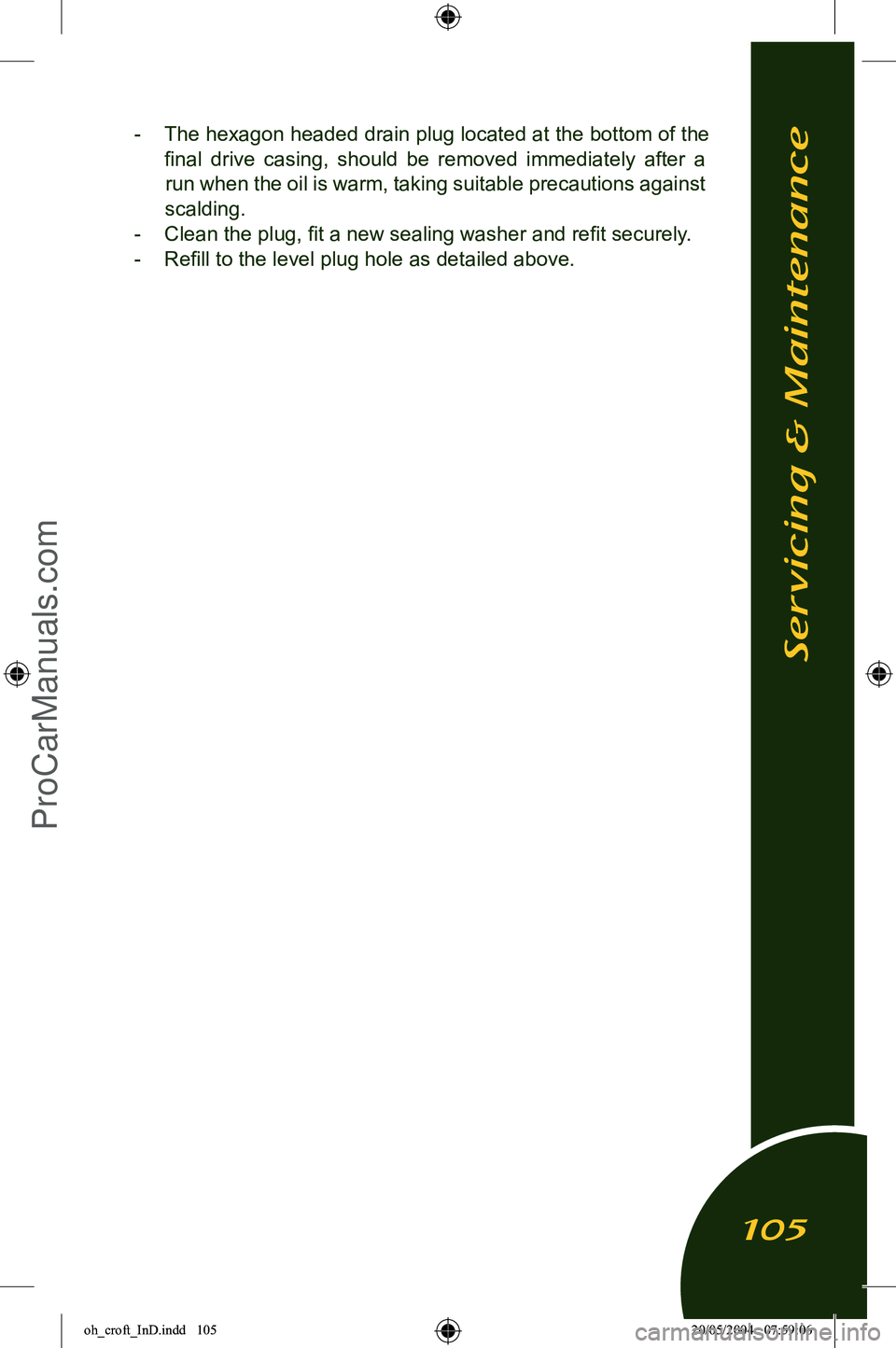
- The hexagon headed drain plug located at the bottom of the final drive casing, should be removed immediately after a run when the oil is warm, taking suitable precautions against
scalding.
- Clean the plug, fit a new sealing washer and refit securely.
- Refill to the level plug hole as detailed above.
Servicing & Maintenance
105
f131
Transmission
filler/level plug
Drain plug
oh_croft_InD.indd 10520/05/2004 07:59:06ProCarManuals.com
Page 108 of 205
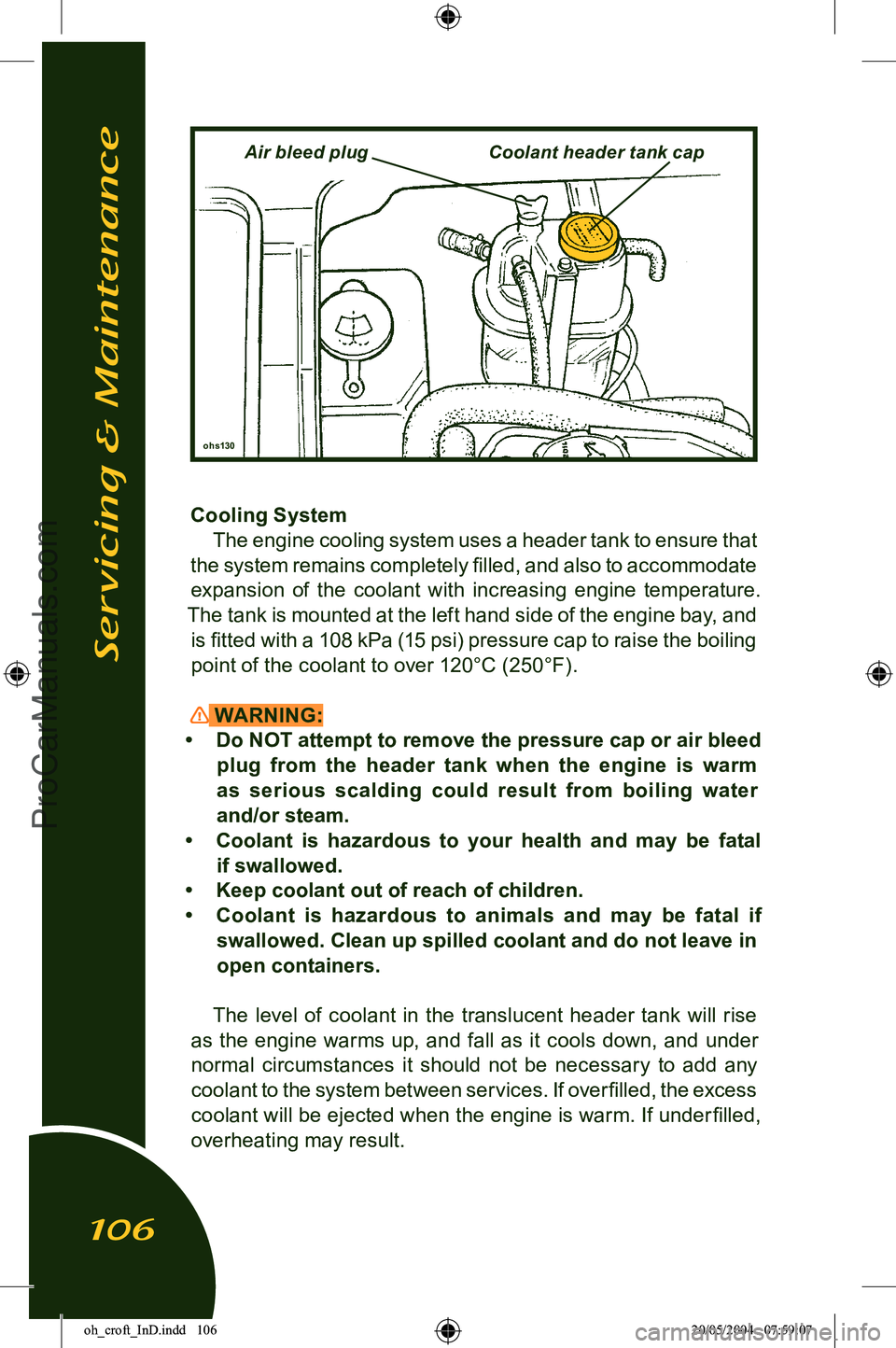
Cooling SystemThe engine cooling system uses a header tank to ensure that
the system remains completely filled, and also to accommodate
expansion of the coolant with increasing engine temperature.
The tank is mounted at the left hand side of the engine bay, and is fitted with a 108 kPa (15 psi) pressure cap to raise the boiling point of the coolant to over 120°C (250°F).
WARNING:
• Do NOT attempt to remove the pressure cap or air bleed plug from the header tank when the engine is warm
as serious scalding could result from boiling water
and/or steam.
• Coolant is hazardous to your health and may be fatal
if swallowed.
• Keep coolant out of reach of children.
• Coolant is hazardous to animals and may be fatal if
swallowed. Clean up spilled coolant and do not leave in
open containers.
The level of coolant in the translucent header tank will rise
as the engine warms up, and fall as it cools down, and under
normal circumstances it should not be necessary to add any
coolant to the system between services. If overfilled, the excess
coolant will be ejected when the engine is warm. If under filled, overheating may result.
Servicing & Maintenance
106
ohs130
Air bleed plugCoolant header tank cap
oh_croft_InD.indd 10620/05/2004 07:59:07ProCarManuals.com
Page 109 of 205
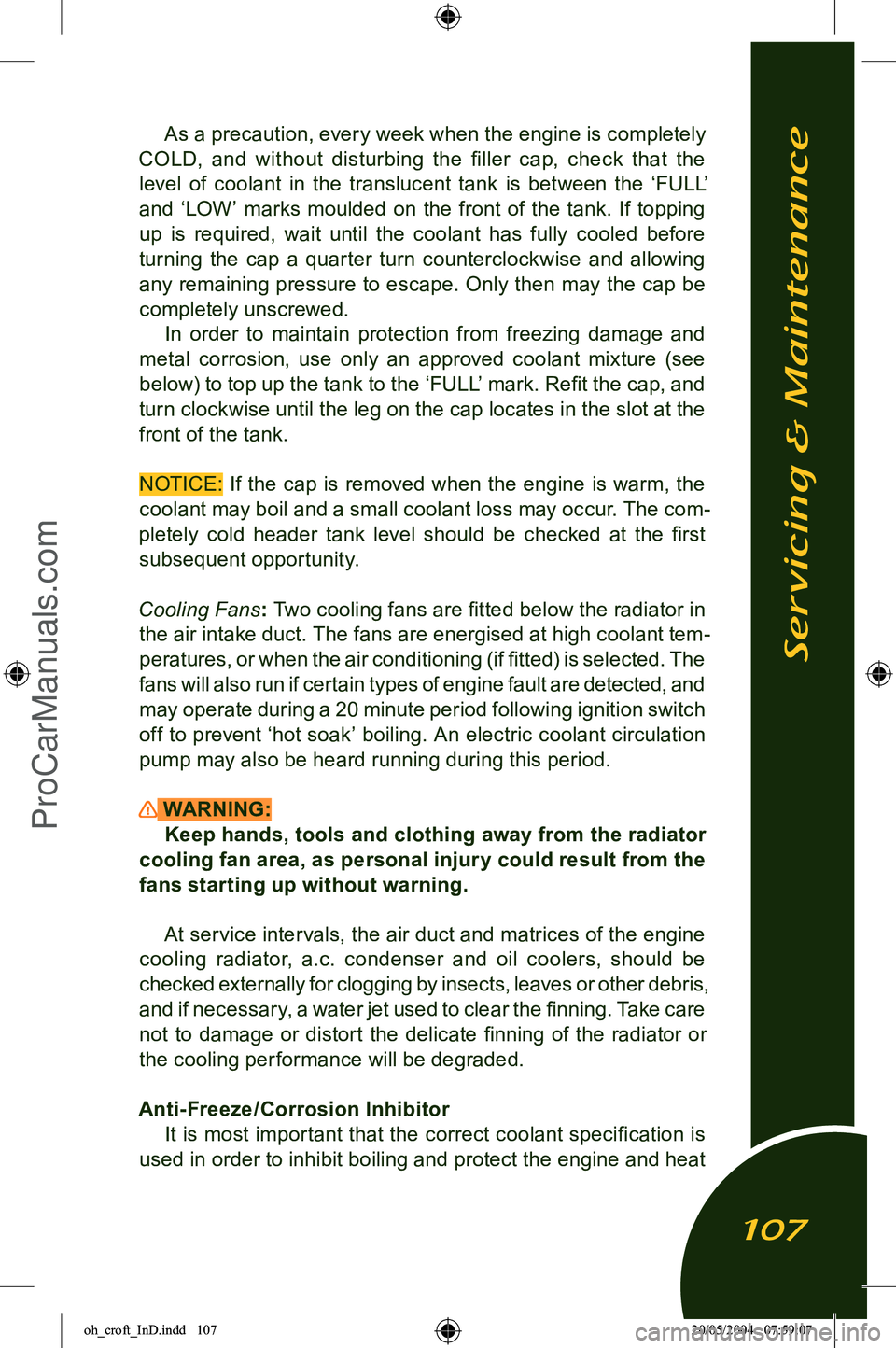
As a precaution, every week when the engine is completely
COLD, and without disturbing the filler cap, check that the level of coolant in the translucent tank is between the ‘FULL’
and ‘LOW’ marks moulded on the front of the tank. If topping
up is required, wait until the coolant has fully cooled before
turning the cap a quarter turn counterclockwise and allowing any remaining pressure to escape. Only then may the cap be
completely unscrewed. In order to maintain protection from freezing damage and
metal corrosion, use only an approved coolant mixture (see below) to top up the tank to the ‘FULL’ mark. Refit the cap, and
turn clockwise until the leg on the cap locates in the slot at the
front of the tank.
NOTICE: If the cap is removed when the engine is warm, the coolant may boil and a small coolant loss may occur. The com
-
pletely cold header tank level should be checked at the first subsequent opportunity.
Cooling Fans
: Two cooling fans are fitted below the radiator in
the air intake duct. The fans are energised at high coolant tem
-
peratures, or when the air conditioning (if fitted) is selected. The
fans will also run if certain types of engine fault are detected, and
may operate during a 20 minute period following ignition switch off to prevent ‘hot soak’ boiling. An electric coolant circulation pump may also be heard running during this period.
WARNING: Keep hands, tools and clothing away from the radiator
cooling fan area, as personal injury could result from the
fans starting up without warning.
At service intervals, the air duct and matrices of the engine
cooling radiator, a.c. condenser and oil coolers, should be
checked externally for clogging by insects, leaves or other debris,
and if necessary, a water jet used to clear the finning. Take care not to damage or distort the delicate finning of the radiator or
the cooling performance will be degraded.
Anti-Freeze/Corrosion Inhibitor It is most important that the correct coolant specification is
used in order to inhibit boiling and protect the engine and heat
Servicing & Maintenance
107
oh_croft_InD.indd 10720/05/2004 07:59:07ProCarManuals.com
Page 110 of 205
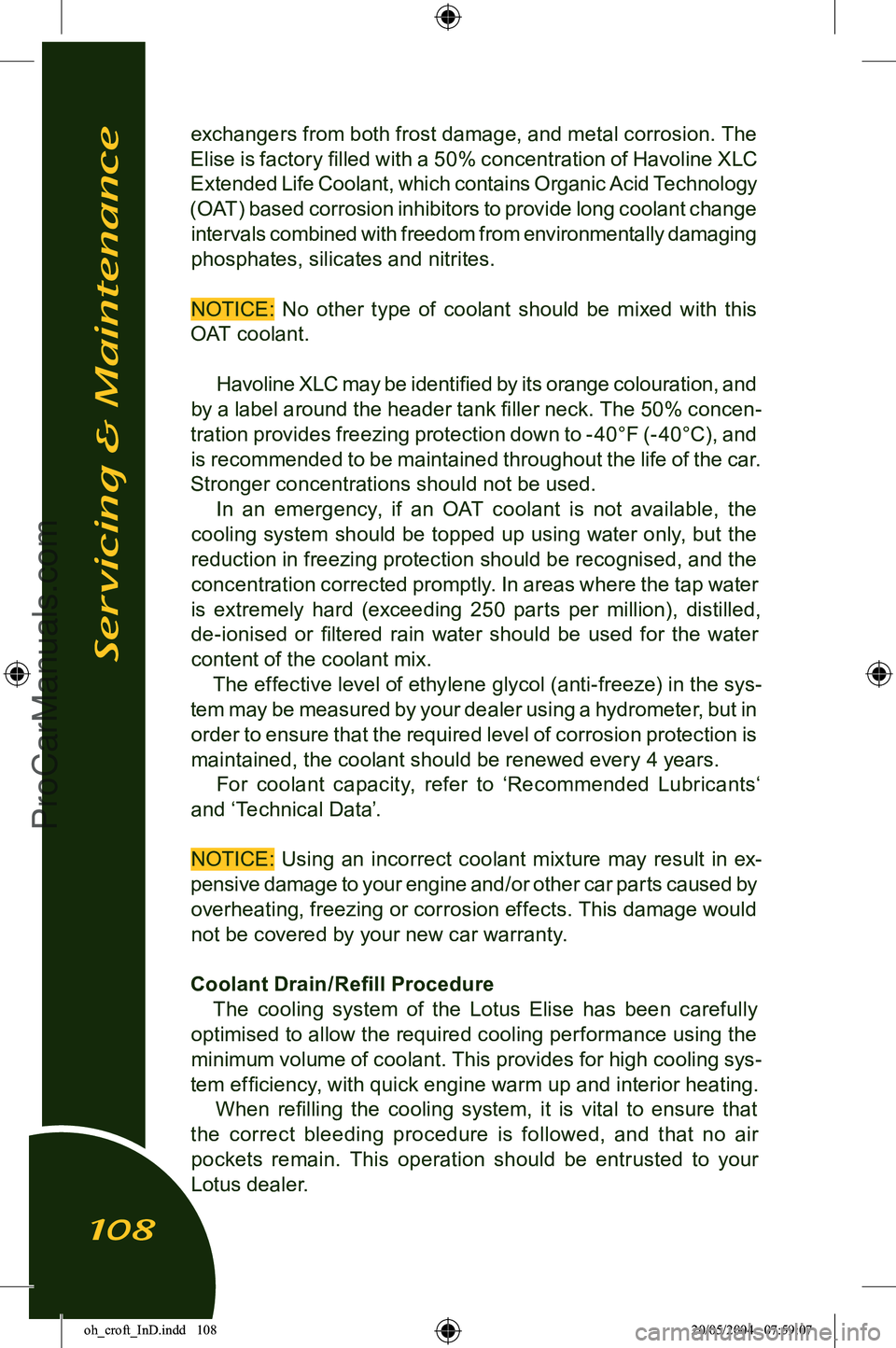
exchangers from both frost damage, and metal corrosion. The
Elise is factory filled with a 50% concentration of Havoline XLC
Extended Life Coolant, which contains Organic Acid Technology
(OAT) based corrosion inhibitors to provide long coolant change intervals combined with freedom from environmentally damaging phosphates, silicates and nitrites.
NOTICE: No other type of coolant should be mixed with this
OAT coolant.
Havoline XLC may be identified by its orange colouration, and
by a label around the header tank filler neck. The 50% concen
-
tration provides freezing protection down to - 40°F (- 40°C), and is recommended to be maintained throughout the life of the car.
Stronger concentrations should not be used. In an emergency, if an OAT coolant is not available, the
cooling system should be topped up using water only, but the reduction in freezing protection should be recognised, and the
concentration corrected promptly. In areas where the tap water is extremely hard (exceeding 250 parts per million), distilled, de-ionised or filtered rain water should be used for the water
content of the coolant mix. The effective level of ethylene glycol (anti-freeze) in the sys
-
tem may be measured by your dealer using a hydrometer, but in order to ensure that the required level of corrosion protection is
maintained, the coolant should be renewed every 4 years. For coolant capacity, refer to ‘Recommended Lubricants‘
and ‘Technical Data’.
NOTICE: Using an incorrect coolant mixture may result in ex
-
pensive damage to your engine and/or other car parts caused by overheating, freezing or corrosion effects. This damage would
not be covered by your new car warranty.
Coolant Drain /Refill Procedure The cooling system of the Lotus Elise has been carefully
optimised to allow the required cooling performance using the
minimum volume of coolant. This provides for high cooling sys
-
tem efficiency, with quick engine warm up and interior heating. When refilling the cooling system, it is vital to ensure that
the correct bleeding procedure is followed, and that no air pockets remain. This operation should be entrusted to your
Lotus dealer.
Servicing & Maintenance
108
oh_croft_InD.indd 10820/05/2004 07:59:07ProCarManuals.com